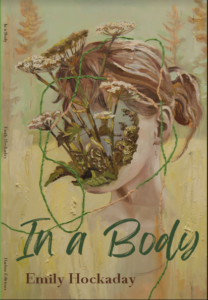 Review by Sharon Tracey
Review by Sharon Tracey
Emily Hockaday’s poetry collection, In a Body, is a study in shape-shifting and an exploration of the intimate relationship between the body and pain as a mother, daughter, and partner. The presence of pain hovers over her motherhood: chronic and like a child tugging on a shirt for attention, always there. She notices and observes, acknowledges and wonders as she makes meaning and connects her own pain to the suffering she sees in the natural world. Along the way, she deftly threads the language and mystery of science within the poems, informing and enriching them.
The shape-shifting begins with the opening poem, “Becoming the Owl” (11) as the poet, taking a lead from her child, becomes avian in her own motherhood, leaving her body to become the mother owl and so “scan the tiny people scurrying below me.”
In “Body After Dry Drowning” (12) the pain inside the body fuses with the suffering of the natural world, the winter fire in the poet’s veins likened to wildfires in Australia and the Amazon. The pain flickering in the light and mirroring the environmental degradation as Hockaday continues—
… the skin
on the heel of my foot is crisscrossed
with cracks. I want to be like the Earth,
but I want to be treated better.
My typography is more scarred
but also softer. The storms become…
Other poems unspool over the Williamsburg Bridge, under the Amtrak train, in a subway car, at the confluence of the Hudson and East Rivers. In “Destruction of the ProtoUniverse on the Morning Commute” (14) she writes, “There is an appeal / in learning the boundaries by trying / to break them. And Hockaday shows us ways in which it might be done—mother to owl, organ to organ, metals in a subway pole and metals coursing through human blood, both sharing their origin in cosmic explosions. As the poet’s self merges with the larger world, the poems expand so that the pain spoken of is no longer only personal but also of the Earth. This care and consideration outside of the self adds poignancy and agency in the midst of the environmental degradation we can see everywhere. Some poems hone in on wildness found on a single, urban street. For Hockaday, nature is everywhere, on every treelawn.
Throughout the collection, Hockaday never takes the body for granted and uses a panoply of metaphors for living inside it as in “Body in the Spring” (22) “Out in the woods I rediscovered / my tree stump heart—porous, crumbling.” In other poems, skin is colored and textured like bark; the body expressed as wood, untethered, transparent, before extinction, out of control, in constant flux. Body becomes a boat, a capsule, one that grieves for the natural world as much as for itself. In the midst of so many meanings, the poet writes, “I know if I sink far enough / I’ll be below the pain; I’ll find bedrock.” (71)
The beauty and strength of the collection is in how the poet manages to take the isolation of chronic pain and transform it into a vessel for connecting to the natural world and the reader. Show how pain can enliven the senses, even in its agony. How it offers perspective, a different time-scale in which to consider these shells of ourselves that take us everywhere. Pain makes us pause and feel. To remember to not take the wonders of the body for granted in all its complexity, to recognize our commonalities with other sentient beings and living things with complex lives all their own, drawing upon the same building blocks and breathing the same air.
It is too easy to forget a body in its relationship to the wider world. In these poems, Hockaday artfully uses her own pain to draw attention to all the bodies we call home—every sinew, nerve, organ, spring, fungal network, tree—transmuting across time in a cycle of birth, death, and renewal. As she writes in “Holy Body”(68)
The broken grass bites
into my feet, a lower jaw
with needle teeth. Walking over
the Earth is holy. You
eating blueberries
by the fistful
is holy too…
In a Body by Emily Hockaday
Small Harbor Publishing, 2023, $18.00 [paperback]
ISBN: 9781957248127
Sharon Tracey is the author of Land Marks (Shanti Arts 2022), Chroma: Five Centuries of Women Artists (Shanti Arts), and What I Remember Most is Everything (All Caps Publishing). Her work has appeared in in Radar Poetry, Crab Creek Review, Terrain.org, Lily Poetry Review, The Ekphrastic Review, and elsewhere. She previously served as a director of research communications and environmental initiatives at the University of Massachusetts Amherst.
